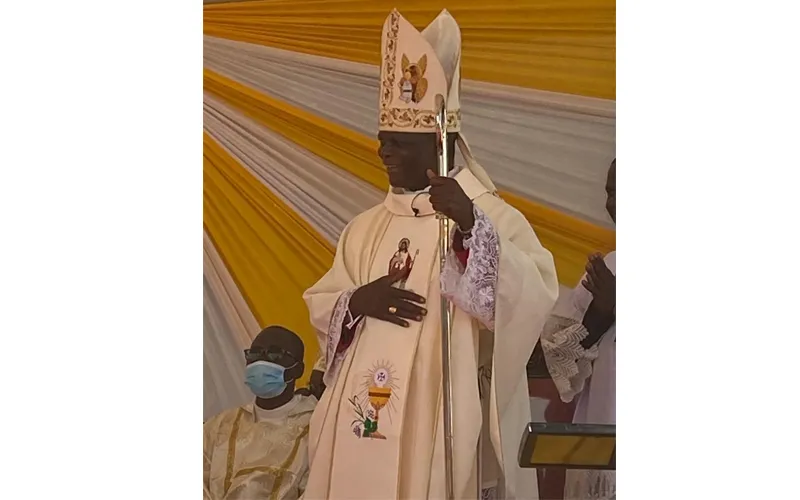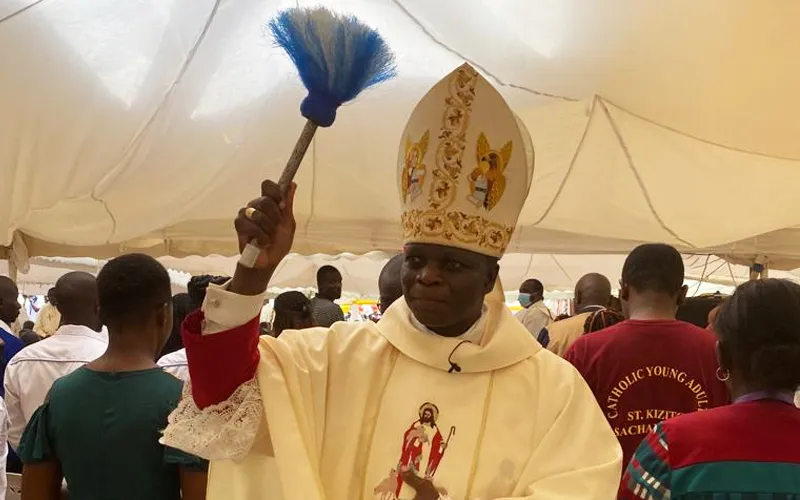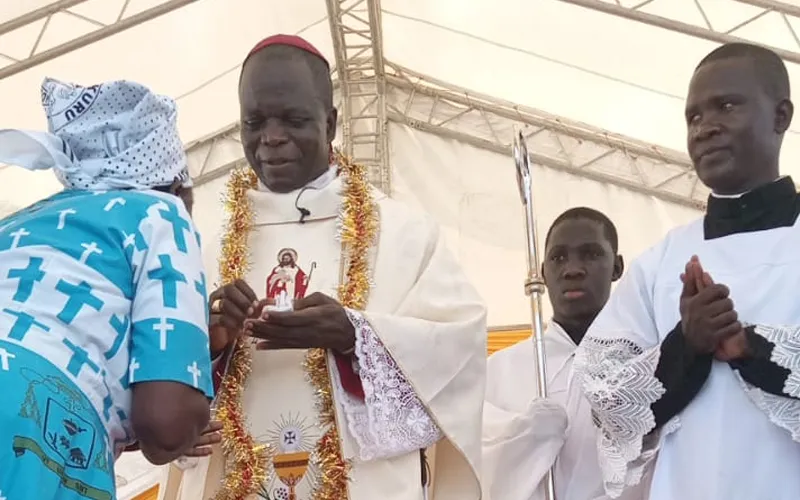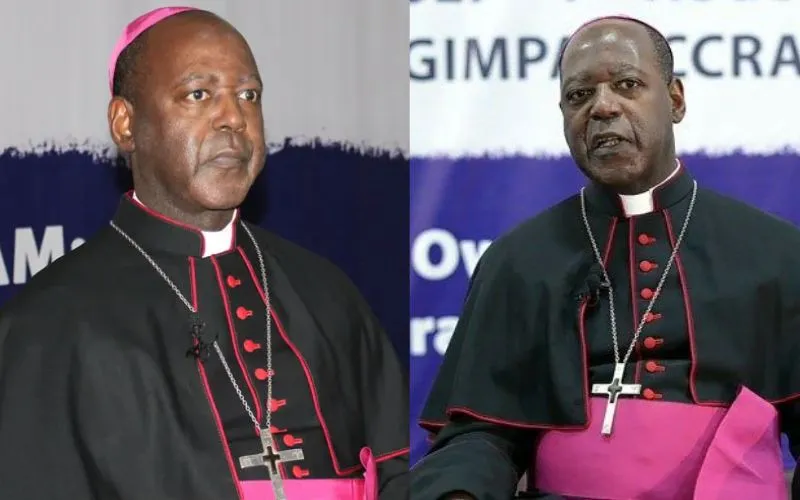 Credit: ACI Africa
Credit: ACI Africa
There is a chalice with grains of wheat on a branch on the side, symbols of the Eucharist, Archbishop Muhatia said.
The Vice Chairman of the Kenya Conference of Catholic Bishops (KCCB) and Principal Administrator of Kenya’s Catholic Secretariat explained, “I will be dedicating my Episcopate in the Archdiocese of Kisumu to the Most Blessed Sacrament of the Altar, the Sacrament of the Body and Blood of Christ.”
He further explained that the Catechism of the Catholic Church, following upon the spirit of Vatican II, rightly emphasizes that the Eucharist is the source of Christian life.
The Catechism, the new Archbishop went on to explain, goes on to say that the other sacraments and ecclesiastical mysteries of works of the Apostolate are bound up with the Eucharist and oriented toward it.
(Story continues below)
 Credit: ACI Africa
Credit: ACI Africa
“In the Blessed Sacrament is contained the whole spiritual good of the Church, namely Christ Himself,” Archbishop Muhatia said, and added, “Because the Holy Eucharist is the source and summit of our faith, our way of thinking is attuned to the Eucharist, and the Eucharist in turn, confirms our way of thinking.”
He noted that the centrality of the Eucharist in the life of the Church, particularly in the Archdiocese of Kisumu, could not be overemphasized.
The native of Kenya’s Kakamega Diocese who holds a licentiate and a doctorate in philosophy from the University of Santa Croce in Rome said that the centrality of the Eucharist in his coat of arms is significant, and explained, “The Eucharist makes us one and nourishes us to go into the deep of mission.”
“I dedicate my Episcopate to Jesus in the Eucharist because he is the true anchor of our lives who sends us on a mission to go and cast into the deep for human touch. Together, we shall become catchers for men and women by our solid obedience of faith, unwavering hope, and love unbound,” he said.
 Credit: ACI Africa
Credit: ACI Africa
The lower left part of Archbishop Muhatia’s coat of arms is a man on a boat on a large mass of water. In the man’s hand is a fishing line with fish on it and in the background, there is a mountain and a sky.
The Kenyan Archbishop explained that the second symbolism resonates with Duc in Altum, Latin for “put out into the deep or cast into deep water.”
“This motto is the key to understanding the coat of arms. Duc in Altum are the words of Jesus addressed to Simon (Peter) ‘put out into deep water, and let down the nets for a catch’. Peter had labored the whole night to no avail,” he explained.
The Archbishop of Kisumu said that the words, Duc in Altum, are a typical example of what the Lord says through the Prophet Isaiah, “The word that goes forth from my mouth does not return empty without carrying out my will and succeeding.”
 Credit: ACI Africa
Credit: ACI Africa
He said that the words of Jesus to Simon were not just for success in the miraculous catch of fish but rather, what the Lord was preparing to do through Simon Peter and his companions and the generations that would follow after them.
“Who can fail to see that since after the resurrection of Jesus, the miracle of the multiplication of his followers continues unabated, not just in number but also in quality,” Archbishop Muhatia said.
He added, “It is my desire that by obedience of faith comparable to that of Simon, I, together with the entire family of God in Kisumu, may both experience the multiplication and at the same time become ambassadors of it.”
The anchor is the third and final symbolism inscribed with the sign XP on the right of the coat of arms of Archbishop Muhatia at the bottom.
 Credit: ACI Africa
Credit: ACI Africa
He explained that the anchor is one of the most ancient Christian symbols which reminded Christians during the most difficult times that Christ is their safety.
“Early Christians used the anchor a lot more than the Cross on the tombs of Christians to express that firm home that believers buried in the tombs were admitted into heaven. It was a symbol of hope in future existence,” the Local Ordinary of Kisumu Archdiocese said March 19.
He added, “I say to you the people of Kisumu, we have this hope as an anchor for the soul, firm and secure.”
“The vision and mission of the Archdiocese shall be driven by this conviction. And as the Lord told Simon, so he tells us, ‘Do not be afraid,’” the Kenyan Archbishop said.
Expressing confidence in his coat of arms, Archbishop Muhatia said, “The way of the Eucharist is therefore the privileged path which I choose as the unique launchpad for plunging into the deep.”
“We shall put out into the deep of the grain of wheat the work of human hands so that deep inside, we may own the truth that unless the grain of wheat falls into the earth and dies it remains only a single grain, but that if it dies, it bears much fruit,” he said.
 Credit: ACI Africa
Credit: ACI Africa
“There is no Christianity without sacrifice,” he went on to say, and continued, “It requires the ultimate sacrifice of dying like the grain of wheat to bear abundant fruit. We shall launch into the deep of the chalice of salvation, the fruit of the vine, so that we may be nourished by the unfathomable treasures of the savior.”
The Kenyan Archbishop said that his “pleasant duty” would be to ensure the Church of Kisumu “continues to be anchored in Christ Jesus, the King of eternal glory and thus anchored neither the waves of sea nor the depths of the underworld can prevail against it.”
“I beseech the intercession of St. Joseph, the husband of Mary whose solemnity we celebrate today, has had a huge influence on evangelization in this Archdiocese, through the work done by the Mill Hill Missionaries, significantly the oldest Parish in the Archdiocese is under his patronage,” Archbishop Muhatia said March 19.
Meanwhile, in his speech at the installation event, the Holy Father’s representative in Kenya, Archbishop Hubertus van Megen noted that Archbishop Muhatia has what it takes to steer the Archdiocese of Kisumu to greater heights.
 Credit: ACI Africa
Credit: ACI Africa
“This is a great day today. It is a wow day because of the new Archbishop that we have received, Archbishop Maurice Muhatia Makumba, who has been chosen by the Holy Father to be the third in line now to guide the Archdiocese of Kisumu further and deeper into the kingdom of God,” the Apostolic Nuncio in Kenya said.
He added, “It is the Pope himself who writes that he has seen in the person of Archbishop Maurice Muhatia Makumba the qualities to lead this Archdiocese further and I may personally attest to that he has the qualities. The speech he gave here shows that this is indeed a man of great gifts who will help this Archdiocese to develop further.”
Pledging his support for the new Archbishop, the native of the Netherlands said, “I will accompany you with my prayer and with my effective help wherever it is possible and I trust that all of you all, especially the Clergy will help him to implement and to plant that kingdom of God in the fertile soil of the Archdiocese of Kisumu, the soil of this great Archdiocese which was already plowed and prepared by the missionaries.”
Agnes Aineah is a Kenyan journalist with a background in digital and newspaper reporting. She holds a Master of Arts in Digital Journalism from the Aga Khan University, Graduate School of Media and Communications and a Bachelor's Degree in Linguistics, Media and Communications from Kenya's Moi University. Agnes currently serves as a journalist for ACI Africa.
 Credit: ACI Africa
Credit: ACI Africa



 Credit: ACI Africa
Credit: ACI Africa
 Credit: ACI Africa
Credit: ACI Africa Credit: ACI Africa
Credit: ACI Africa Credit: ACI Africa
Credit: ACI Africa Credit: ACI Africa
Credit: ACI Africa Credit: ACI Africa
Credit: ACI Africa Credit: ACI Africa
Credit: ACI Africa Credit: ACI Africa
Credit: ACI Africa Credit: ACI Africa
Credit: ACI Africa


